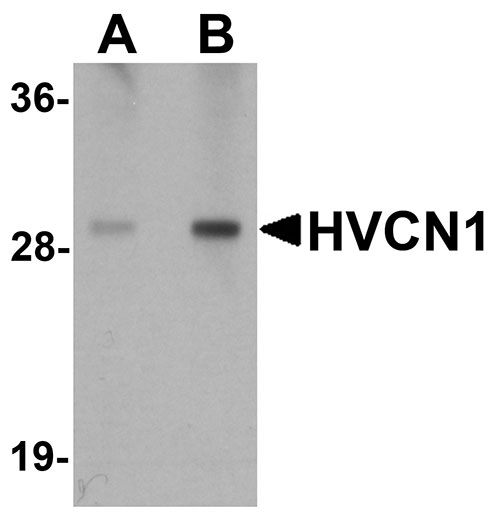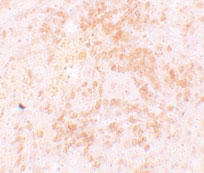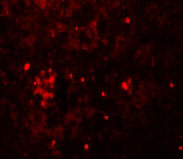HVCN1 Antibody
- 产品详情
- 实验流程
- 背景知识
Application
| WB, IF, E, IHC-P |
|---|---|
| Primary Accession | Q96D96 |
| Other Accession | NP_115745, 91992155 |
| Reactivity | Human, Mouse, Rat |
| Host | Rabbit |
| Clonality | Polyclonal |
| Isotype | IgG |
| Calculated MW | 31683 Da |
| Concentration (mg/ml) | 1 mg/mL |
| Conjugate | Unconjugated |
| Application Notes | HVCN1 antibody can be used for detection of HVCN1 by Western blot at 0.5 - 1 µg/mL. Antibody can also be used for immunohistochemistry starting at 5 µg/mL. For immunofluorescence start at 20 µg/mL. |
| Gene ID | 84329 |
|---|---|
| Other Names | Voltage-gated hydrogen channel 1, Hydrogen voltage-gated channel 1, HV1, Voltage sensor domain-only protein, HVCN1, VSOP |
| Target/Specificity | HVCN1; |
| Reconstitution & Storage | HVCN1 antibody can be stored at 4℃ for three months and -20℃, stable for up to one year. As with all antibodies care should be taken to avoid repeated freeze thaw cycles. Antibodies should not be exposed to prolonged high temperatures. |
| Precautions | HVCN1 Antibody is for research use only and not for use in diagnostic or therapeutic procedures. |
| Name | HVCN1 {ECO:0000303|PubMed:20037153, ECO:0000312|HGNC:HGNC:28240} |
|---|---|
| Function | Voltage-gated proton-selective channel that conducts outward proton currents in response to intracellular acidification. Lacks a canonical ion-channel pore domain and mediates proton permeability via its voltage sensor domain (PubMed:16554753, PubMed:20037153, PubMed:20548053, PubMed:22020278, PubMed:27859356, PubMed:30478045, PubMed:37669933). Appears to play a dominant role in regulation of CO2/HCO3(-)/H(+) equilibrium in sperm flagellum. Prevents the acidification resulting from HCO3(-) synthesis and thus sustains high HCO3(-) levels inside sperm for capacitation (PubMed:20144758, PubMed:30478045, PubMed:37669933). Provides for proton efflux that compensates for electron charge generated by NADPH oxidase activity either in the extracellular or phagosomal compartments, thus enabling the production of high levels of bactericidal reactive oxygen species during the respiratory burst (PubMed:20037153, PubMed:30478045). Opens when the pH of airway surface liquid exceeds 7 and contributes to respiratory epithelial acid secretion to maintain pH in the mucosa (PubMed:20548053). |
| Cellular Location | Cell membrane; Multi-pass membrane protein. Apical cell membrane; Multi-pass membrane protein. Cytoplasmic vesicle, phagosome membrane; Multi-pass membrane protein. Cell projection, cilium, flagellum membrane; Multi-pass membrane protein. Note=Detected within the principal piece of the sperm flagellum (PubMed:20144758). Detected mainly at intracellular membranes upon overexpression in HeLa cells (PubMed:20147290) |
| Tissue Location | Enriched in immune tissues, such as lymph nodes, B- lymphocytes, monocytes and spleen (PubMed:16554753). Expressed in spermatozoa (PubMed:37669933). Expressed in respiratory epithelial cells (PubMed:20548053). |
For Research Use Only. Not For Use In Diagnostic Procedures.
Provided below are standard protocols that you may find useful for product applications.
BACKGROUND
HVCN1 Antibody: HVCN1 (hydrogen voltage-gated channel 1), a voltage gated proton channel protein that is highly expressed in immune tissues, mediates the proton conductances required by phagocytic leukocytes for the oxidative burst that underlies microbial killing. HVCN1 moderates the voltage-dependent proton permeability of excitable membranes by allowing the flow of protons in accordance to their electrochemical gradient. HVCN1 is sensitive to zinc ions, and can be inhibited by them. HVCN1 may represent a new therapeutic target for B cell malignancies on continued signaling via the B cell antigen receptor.
REFERENCES
Ramsey IS, Moran MM, Chong JA, et al. A voltage gated proton-selective channel lacking the pore domain. Nature2006; 440:1213-6.
Sasaki M, Takagi M, and Okamura Y. A voltage sensor-domain protein is a voltage-gated proton channel. Science2006; 312: 589-92.
Morgan D, Capasso M, and Musset B. Voltage-gated proton channels maintain pH in human neutrophils during phagocytosis. Proc. Natl. Acad. Sci. USA2009; 106:18022-7.
Capasso M, Bhamrah MK, Henley T, et al. HVCN1 modulates BCR signal strength via regulation of BCR-dependent generation of reactive oxygen species. Nat. Immunol.2010;11:265-72.
终于等到您。ABCEPTA(百远生物)抗体产品。
点击下方“我要评价 ”按钮提交您的反馈信息,您的反馈和评价是我们最宝贵的财富之一,
我们将在1-3个工作日内处理您的反馈信息。
如有疑问,联系:0512-88856768 tech-china@abcepta.com.























 癌症的基本特征包括细胞增殖、血管生成、迁移、凋亡逃避机制和细胞永生等。找到癌症发生过程中这些通路的关键标记物和对应的抗体用于检测至关重要。
癌症的基本特征包括细胞增殖、血管生成、迁移、凋亡逃避机制和细胞永生等。找到癌症发生过程中这些通路的关键标记物和对应的抗体用于检测至关重要。 为您推荐一个泛素化位点预测神器——泛素化分析工具,可以为您的蛋白的泛素化位点作出预测和评分。
为您推荐一个泛素化位点预测神器——泛素化分析工具,可以为您的蛋白的泛素化位点作出预测和评分。 细胞自噬受体图形绘图工具为你的蛋白的细胞受体结合位点作出预测和评分,识别结合到自噬通路中的蛋白是非常重要的,便于让我们理解自噬在正常生理、病理过程中的作用,如发育、细胞分化、神经退化性疾病、压力条件下、感染和癌症。
细胞自噬受体图形绘图工具为你的蛋白的细胞受体结合位点作出预测和评分,识别结合到自噬通路中的蛋白是非常重要的,便于让我们理解自噬在正常生理、病理过程中的作用,如发育、细胞分化、神经退化性疾病、压力条件下、感染和癌症。








